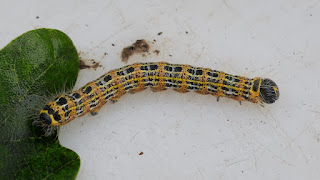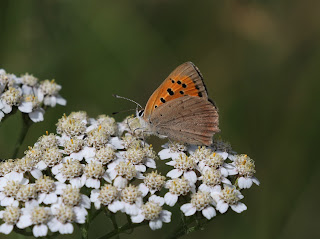Wednesday 2nd August 2023, Corfields, Westhope
The clouds were gathering as we met in the site’s car park. We were rather slow in getting ready as some of the group were delayed by traffic.
This gave us time to explore the car park. And, as with most car parks, it was a site worth visiting.
A Pale tussock moth larva was beaten from an oak;
 |
| Photograph: Nigel Cane-Honeysett |
A mirid bug, Malacocoris chlorizans, was dislodged from a hazel in the hedge;
 |
| Photograph: David Williams |
And a Marble gall caused by the gall wasp Andricus kollari was found on an oak.
 |
| Photograph: John Lyden |
There is a small insect on the gall in the above photograph. This is a gall wasp, probably a Synergus species which is an inquiline of the gall, that is, it will lay its eggs in the gall and its larvae will develop within the gall.
 |
| Photograph: John Lyden |
The gathering clouds had collected sufficiently to create a heavy shower of rain. Fortunately, as we had not progressed from the car park some were able to shelter in their cars and others took cover in a small open hut at the entrance.
The shower soon passed, and we made for the site.
The access point took us into a large meadow.
Most of the flora had gone over to seed but it looked as though it would have been a very pleasant sight in flower.
The meadow was surrounded by a border of rough vegetation with one side being woodland and most of the other sides being decent hedgerow.
When searching a meadow, we tend to stick to the edges, which is where we tend to find the greatest variety of invertebrates.
A Buff-tip moth larva was beaten out of one of the oaks that were part of the hedgerow;
 |
| Photograph: David Williams |
And a tiny spider, Paidiscura pallens, was spotted close to a couple of sputnik-shaped egg-sac on the underside of an oak leaf.
 |
| Photograph: Nigel Cane-Honeysett |
Lurking in the bramble, nettle, cleavers and other taller plants making up the border we found:
A Speckled bush cricket;
 |
| Photograph: David Williams |
A nymph of a Green shieldbug;
 |
| Photograph: Nigel Cane-Honeysett |
A tachinid fly, Tachina fera (on the left), together with a conopid fly, Conops quadrifaciatus.
 |
| Photograph: John Martin |
By now we had reached the top of the meadow – and paused to look back at the view.
A gate to the woodland was not far away. Passing through we followed the path to a clearing used for woodland activities. Here, there was a shelter with tree stumps and other seats on which we could rest and eat lunch.
Whilst eating, we heard a pitter-patter on the roof, followed by drumming, as more rain descended.
Fortunately (again) we were sheltered from this shower by the shelter!
As before, it soon stopped and the sun broke through the clearing clouds.
Lunch over we spent a little time exploring the woodland.
A leaf-mine was spotted on the leaf of the Burdock next to the shelter, caused by the larva of the fly Phytomyza lappae eating its way through the fabric of the leaf.
 |
| Photograph: John Lyden |
With this mine you can follow the progress of the larva from where it starts to feed (the narrowest end), creating a wider mine as it grows until it finally vacates the leaf at the widest end. The little black dots are the frass the larva produces as it feeds. The pattern of the path and the frass can sometimes be enough to identify the species that created the mine.
Other species noted in this area included:
Bifid hemp-nettle;
 |
| Photograph: John Martin |
A beetle, Malthinus flaveolus;
 |
| Photograph: Nigel Cane-Honeysett |
And a curious growth on the trunk of the tree. At first it was thought to be a fungus but it has now been suggested that it may be a slime mould, Metatrichia floriformis.
%20NCH%202023-08-02.jpg) |
| Photograph: Nigel Cane-Honeysett |
Carrying on through the wood we came to a stile that gave access to a field. Once we had clambered over it, inelegantly, we paused to take in the view.
We passed through a couple more fields to a wetter area of the site by a stream. On the way we spotted:
A large hoverfly, Volucella inanis;
 |
| Photograph: John Lyden |
A pair of mating Common blue butterflies;
 |
| Photograph: John Martin |
A Peacock butterfly;
 |
| Photograph: Nigel Cane-Honeysett |
And a Dusky thorn moth.
 |
| Photograph: Nigel Cane-Honeysett |
By now we had all arrived at the area by the stream. Here the vegetation was much taller and denser.
However, the many umbellifers and the trees along the edge of the stream were a magnet for insects. These included:
Cream-spot ladybird;
 |
| Photograph: David Williams |
A large fly, Phasia hemiptera;
 |
| Photograph: John Martin |
A Common blue butterfly (at the top) and the tachinid fly, Eriothrix rufomaculata, sharing a thistle flower;
 |
| Photograph: Nigel Cane-Honeysett |
A Ruddy darter;
 |
| Photograph: John Lyden |
And a harvestman, Dicranopalpus ramosus agg.
 |
| Photograph: Nigel Cane-Honeysett |
Why the agg.?
Dicranopalpus ramosus used to be easy to identify as it was the only species with palps that split rather like a tuning fork in Britain. But, lo, and behold, other species have been found that share the same characteristic and look similar. As separation depends on an intimate examination of the specimen it is convenient to record it as an aggregate species.
As the day was drawing to a close and members were winding down, we investigated the field leading to the last area. It did not disappoint.
Slender groundhoppers;
 |
| Photograph: David Williams |
A Small copper butterfly;
 |
| Photograph: John Martin |
And a Herald moth.
 |
| Photograph: Caroline Uff |
Looking up we noticed that the clouds had gathered once again, and it appeared that more rain was on the way. We headed back to the cars.
Fortunately, we did not get wet on the way.
Other news
Trips to Nottinghamshire, Benson in Oxfordshire and the Lleyn Peninsula in search of ladybirds and bush crickets were successful. Unfortunately, the travelling was not, with multiple traffic hold-ups and confusing road closures. But let’s concentrate on the successes.
In Nottinghamshire the first encounter was with a “Mealybug destroyer”. This is a ladybird, Cryptolaemus montrouzieri, which is imported from Australia and used to, as the name suggests, control mealybugs on plants which are in hot-houses.
 |
| Photograph: David Williams |
A second ladybird was found later, also an arrival from Australia, Rhyzobius forestieri. This was found outdoors.
 |
| Photograph: David Williams |
A non-ladybird was the nymph of a Western conifer seed bug. This is also an “import”. This time from America. Although it is well established in Europe and probably arrived over from there.
 |
| Photograph: David Williams |
At Bensons the species of interest was Bryony ladybird. This ladybird arrived from mainland Europe in the 1990s. In England it seems to feed exclusively on White bryony. This is a photograph of the adult on the left and larva on the right. The discoloured patch at the bottom is where they have been feeding.
 |
| Photograph: David Williams |
A second find of note was a nymph of the Southern oak busk cricket.
 |
| Photograph: David Williams |
Finally, to the Lleyn Peninsula where the species looked for and located was Grey bush cricket.
 |
| Photograph: David Williams |
This outing also brought sightings of:
Choughs;
 |
| Photograph: David Williams |
A Boat bug;
 |
| Photograph: David Williams |
And, in the sea, a family of Dolphins.
 |
| Photograph: David Williams |
Apley Woods
Some photographs of insects found at Apley Woods that arrived too late to be included in the recent report of this visit.
A "picture-wing" fly, Clusia tigrina;
 |
| Photograph: John Martin |
Another fly, the conopid, Physocephala rufipes;
 |
| Photograph: John Martin |
And a Roesel’s bush cricket.
 |
| Photograph: John Martin |
Thank you to the owner of Corfields for allowing us to enjoy ourselves, and to the photographers whose brilliant images illuminate this tale.
.JPG)
.JPG)
.JPG)
.JPG)


























Love reading your reports and admiring the amazing photos.
ReplyDelete